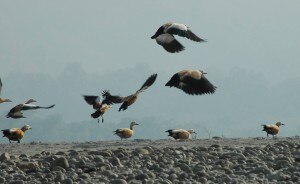Shrinking wetlands, deforestation fuelling migratory birds' decline in Himalaya

KATHMANDU, Nepal-Due to global warming coupled with rapid decrease of trees and wetlands, the number of migratory birds visiting the Himalayan nation Nepal to stay during summer and winter have dropped down sharply in the last few years.
Beside climate change, rapid urbanization and deforestation are some of the major causes behind the decline in the number of migratory birds coming to this reason, according to bird experts.
Veteran ornithologist Hem Sagar Baral said unplanned urbanization have quite affected the birds’ habitant ‘though it may not be good to pinpoint as the main causes behind birds’ decline.
Baral who is also an adjunct senior lecturer at the School of Environmental Sciences at Charles Sturt University in Australia and country manager of the Conservation Program in Nepal overseen by the Zoological Society of London calculated that the decline in numbers could be at around 20 percent.
“There has not exactly been a gradual loss if we look at every year´s graph. However, compared to 10 or 15 years ago, we can assess that the numbers are lesser by around 20 percent,” my republica quoted Baral as saying.
Similarly, in the opinion of another bird expert Suchit Basnet , both summer and winter migratory birds that come here are being affected as the wetlands here in Nepal are gradually shrinking.
A study carried out in 2010 stated that 149 bird species in Nepal (17 percent of the total recorded) were considered nationally threatened while 53 were critically endangered species. Likewise, 48 bird species were endangered and 47 vulnerable.
Various bird species like eagles, falcons and ducks arrive in this region all the way from Siberia, Mongolia, China and Eastern Europe and settles in various parts of Nepal.
Birds’ specialists have of the opinion that the migratory birds travel around 4,000 to 5,000 miles to arrive Nepal. While the non-stop traveler birds execute their long journey within just two days, others take around nearly 10 days.
The migratory birds come here via Kaligandaki Valley in the west and the Arun Valley in the east. According to experts around 160 species of birds arrive in Nepal in summer while 60 species in winter.

